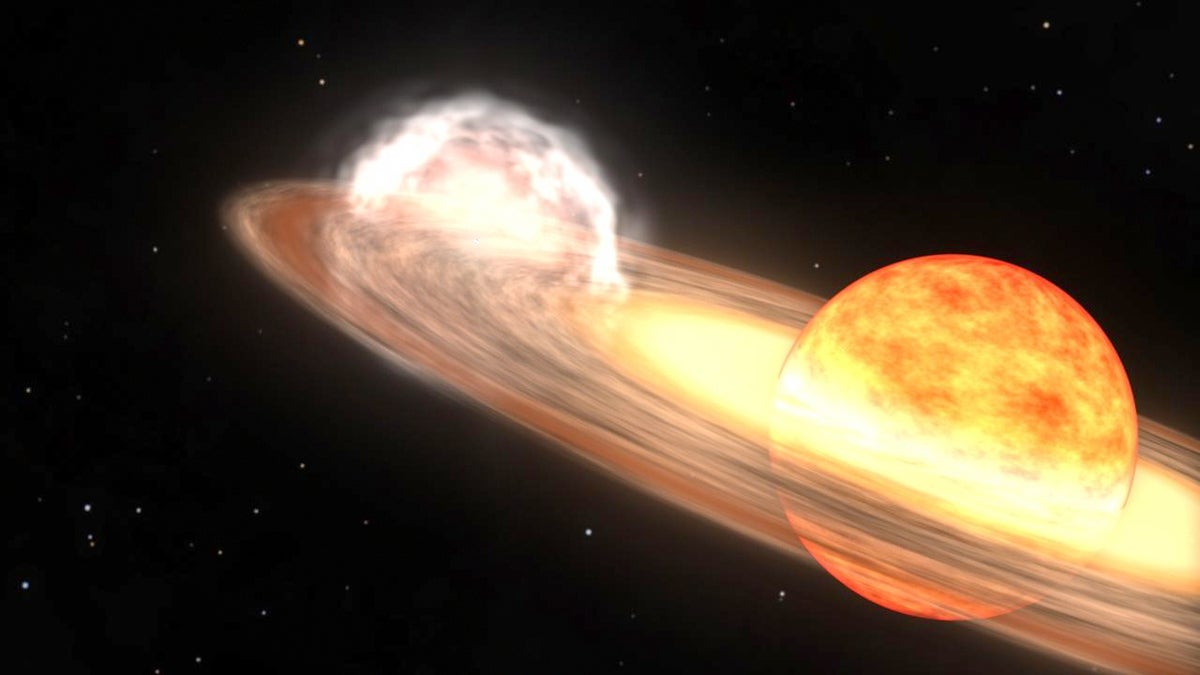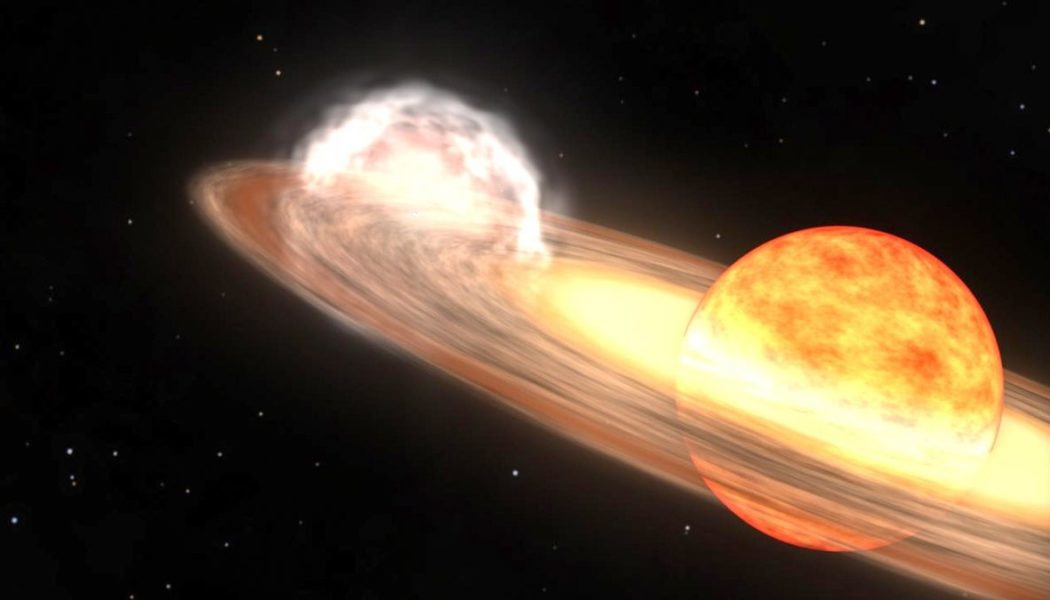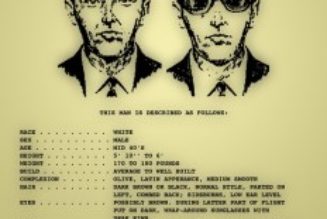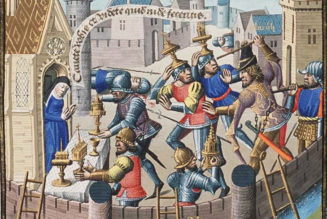
In October 1217 the abbot of the Ursberg Abbey in present-day southern Germany looked to the firmament and, in the arc-shaped constellation Corona Borealis, saw something wondrous. “It was originally a faint star that for a time shone with great light and then returned to its original faintness,” he wrote in Latin at the time. He wasn’t the first to see it, nor was he the last. This stellar apparition emerges, then vanishes, every 80 years or so—and that’s because it isn’t really a star at all. That abbot witnessed a thermonuclear explosion 3,000 light-years away. It came from a white dwarf, a stellar zombie that’s devouring matter from a nearby red giant star. Once a century, it gets full, and when it does, it erupts, unleashing a week-long hellfire.
This is T Coronae Borealis—often shortened to T CrB—and it’s what astronomers call a nova, a word that is derived from the Latin description of these events as “new stars,” which many premodern observers assumed them to be. T CrB last erupted in 1946, and its behavior suggests that its next paroxysm is due any moment between now and September. When this occurs, T CrB will become visible to the naked eye as a temporary jewel in its constellation’s stelliferous crown. And far from treating it as a mere spectacle, astronomers are going to use this latest outburst as a chance to learn more about novae, which are oft-overlooked drivers of cosmic chaos.
“[Novae] are completely weird events,” says Bradley Schaefer, an astrophysicist at Louisiana State University. But T CrB is unique: it undergoes a rollercoaster of brightening and dimming that defies conventional wisdom. Sometimes studying the outliers is the best way to understand the population. That’s why, “when T CrB goes off, a large fraction of every telescope in the world is going to be pointed at it,” Schaefer says.
On supporting science journalism
If you’re enjoying this article, consider supporting our award-winning journalism by subscribing. By purchasing a subscription you are helping to ensure the future of impactful stories about the discoveries and ideas shaping our world today.
To understand why T CrB has got astronomers so hyped, it helps to have a primer on your average nova. Each one involves a perilous pairing between a white dwarf, the small carcass left behind at the end of certain stars’ life, and a “normal” companion star—in the case of T CrB, a puffy red giant. The white dwarf is so dense that it’s able to gravitationally pilfer hydrogen from its companion, which snows onto the dwarf’s surface. This veneer heats up and eventually ignites, sparking an unstoppable chain reaction that culminates in a nuclear explosion.
“This is like a gigantic hydrogen bomb that blasts off the entire atmosphere of this Earth-size white dwarf,” says Ole König, an astronomer at Friedrich-Alexander University of Erlangen- Nuremberg in Germany. These explosions aren’t supernovae, their more cataclysmic cousins that result in a star’s annihilation. But that doesn’t make them much less impressive or important.
Novae repeatedly and catastrophically erupt, somehow without destroying their stellar progenitors, all while enriching their celestial surroundings with a potent mix of fresh-forged material. “Novae are producers of elements needed for life, such as carbon, nitrogen and oxygen,” and could be one of the main producers of lithium, says Michael Healy-Kalesh, an astrophysicist at Liverpool John Moores University in England.
That suggests you can’t fully understand how astrophysics gives rise to biology without decoding novae. And when astronomers are lucky, they find recurrent novae—those that erupt at least once per century—as predictable beacons for their studies. Including T CrB, they’ve only managed to find about 10 in the Milky Way, however. And despite T CrB’s apparent clockworklike dependability, astronomers of yore have proved fickler; the system’s eruptions have only documented for the years 1217, 1787, 1866 and 1946. Based on subtle details observed during its prior two recorded outbursts, “the official prediction is that it’ll go off around April, maybe May, give or take three months,” Schaefer says—and it should be visible for several days.
Some of the world’s leading observatories are already slated to opportunistically turn their attentions to T CrB when the time comes and record its explosion in optical, radio, x-ray and other wavelengths of light. Amateur astronomers are on the case, too. “Our members love things that go boom,” says Brian Kloppenborg, an astrophysicist at the American Association of Variable Star Observers in Cambridge, Mass. “I get an e-mail once every 10 minutes with some new observations.”
Such full-spectrum vigilance could transform T CrB from a cosmic oddity to an answer key for riddles applicable to all novae. For example, how hasty are their outbursts? X-ray astronomy can help with that. When an eruption happens, “you have this hot, glowing fireball,” König says, one that emits x-rays. As it expands, the white dwarf’s expelled shell cools down and subsequently emits optical radiation. The time difference between the x-ray and optical flashes can clock how fast the jettisoned material is moving.
Cosmic cataclysms of all sorts also produce neutrinos, almost-massless particles that can reveal otherwise-hidden internal details of the formidable processes that unleashed them. But they are notoriously hard to detect, and to date, “no neutrino has been recorded from any nova,” says Ulisse Munari, an astronomer at the University of Padua in Italy. But knowing when and where a neutrino-making nova will flare up certainly helps. “There’s actually a real chance that current-generation neutrino detectors can detect T CrB,” Schaefer says. If this turns out to be the case, scientists could gain a new view of the explosive physics of all novae.
Yet it’s arguably not how novae explode but what they may become that most animates many astronomers. “The aspect I find the most exciting is the potential of novae as progenitors of type 1a supernovae,” Healy-Kalesh says. Like standard novae, this flavor of supernovae involves mass exchange between a pair of stars, at least one of which is a gas-guzzling white dwarf. Yet their resulting thermonuclear detonation is so immense that the matter-accreting white dwarf is blown to smithereens.
One of the prevailing models for a type 1a supernova involves a white dwarf that has gorged itself on so much stellar matter that its mass increases to 1.4 times that of the sun—something known as the Chandrasekhar limit. Beyond this threshold, the white dwarf becomes too bulky to support its own weight, triggering a thermonuclear cascade that causes it to explosively self-destruct. The key question, then, is: “How do these white dwarfs accrete enough material to surpass the Chandrasekhar limit?” König says. And because type 1a supernovae in principle all blow up the same way regardless of their cosmic coordinates, their detonations serve as important ticks on astronomers’ rulers for gauging vast intergalactic distances; teasing out any quirks in the similar-but-smaller explosions of regular, not-so-super novae, then, could lead to subtle tweaks to type 1a-based (mis)measurements of the universe.
Researchers are also eager to study the recurrent mechanics of run-of-the-mill novae, which may change over time if or when a white dwarf’s gathered matter isn’t entirely consumed or ejected during each of its explosions. “How much of that matter stays on the white dwarf? How much is blown off in a nova?” says Deanne Coppejans, an astrophysicist at the University of Warwick in England. This apocalyptic balance sheet can be checked during T CrB’s next outburst: the white dwarf is mainly made of carbon and oxygen, while the red giant is donating hydrogen, providing a bulk ingredients list from which relative proportions within a nova’s ejecta can be ascertained.
Astronomers are also aiming to use T CrB’s imminent eruption to understand this specific nova’s three baffling idiosyncrasies. “No other novae that we know exhibit such behaviors,” says Vladislav Marchev, an astronomer at the Institute of Astronomy in Bulgaria.
Most novae stay dim, dramatically brightening only during an eruption—but not T CrB. Its first oddity is that for about a decade both before and after an explosion, it exists in a “high state” of modest brightness, emitting “a hot, blue, violent light,” Schaefer says. “Why does the high state turn off? For that matter, why does the high state turn on? We don’t have the faintest idea as to what’s going on.”
The second strange feature is its pre-eruption brightness dip, which happens about a year prior to the eruption. “It’s a weird, unprecedented mystery—and it’s also a harbinger of an upcoming eruption,” Schaefer says. Some have suggested that as the white dwarf’s accreted matter is approaching its “well done” phase, it gains a “char” of sorts, a veil of dust that obscures the scorching-hot bonfire below. Perhaps “T CrB is ejecting gas prior to its eruption, which goes on to form shells of dust and blocks out light from the central system, causing the pre-eruption dip,” Healy-Kalesh says.
Third, a couple of months after T CrB’s explosion, it seems to produce a secondary eruption —bright but not rising to the brightness of the initial outburst—that can last for several weeks or months. “The secondary maximum has been a long-lasting mystery,” Munari says. But he offers a possible solution in a recent preprint: it’s an illusion, not another eruption.
During its accretionary phase and its outburst, the white dwarf is flambéing the visible hemisphere of the red giant. After the eruption, the white dwarf may be cooling down, but the red giant’s conflagration-facing side is still sizzling—and when that hot hemisphere faces Earth, astronomers glimpse that glow and erroneously perceive it to be a second eruption. “I think it might be true,” Schafer says. And when T CrB actually unleashes its hellfire, everyone will be able to assess Munari’s idea.
Altogether this eruption is “truly a once-in-a-lifetime experience,” Kloppenborg says—a chance for astronomers to find answers to century-old questions. “We’re going to throw everything at it,” Schaefer says. Nothing exhilarates him more, however, than the opportunity to show the public that deep-space astronomy isn’t esoteric but something tangible. “This will be visible for anyone,” he says. “Anyone can go out and look at it. That might be the most exciting thing about this.”









